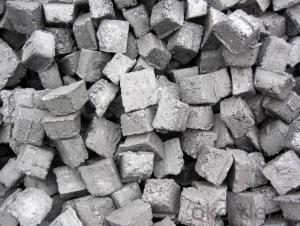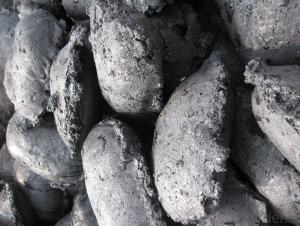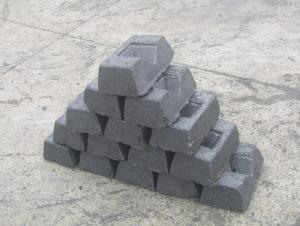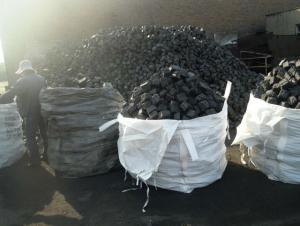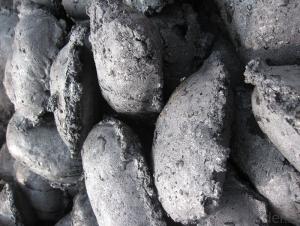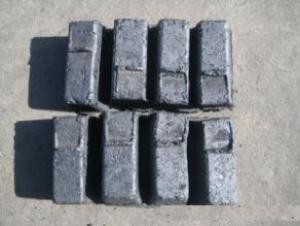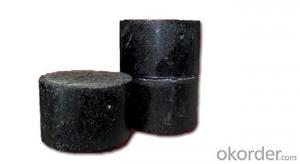Carbon Electrode Paste with Low Ash for Ferroalloy Calcium Carbide Manufacture
- Loading Port:
- Lianyungang
- Payment Terms:
- TT or LC
- Min Order Qty:
- 20 m.t.
- Supply Capability:
- 1000 m.t./month
OKorder Service Pledge
OKorder Financial Service
You Might Also Like
Spcifications
Carbon Electrode Paste with Low Ash 7%
1:carbon eletrode paste
2:for ferroalloy,calcium carbide manufacture
3:HS 3801300000,YB/T5212-1996,ISO9001:2008
Product Description
Carbon Electrode Paste with Low Ash 7%
Carbon Electrode Paste is a self-baking electrode used in submerged arc furnaces for delivering power to the charge mix. Electrode Paste is added to the top of the electrode column in either cylindrical or briquette form. As the paste moves down the electrode column the temperature increase causes the paste to melt and subsequently bake forming a block of electrically conductive carbon. Electrode Paste is essentially a mix of Electrically Calcined Anthracite (ECA) or Calcined Petroleum Coke (CPC) with Coal Tar Pitch.
Carbon Electrode Paste with Low Ash 7%
Detailed Specs
Ash 4.0%max5.0%max 6.0%max7.0% Max9.0% Max11.0% Max
VM 12.0%-15.5%12.0%-15.5%12.0%-15.5%9.5.0%-13.5%11.5%-15.5%11.5%-15.5%
Strength
Compress 18.0Mpa Min17.0Mpa Min15.7Mpa Min19.6Mpa Min19.6Mpa Min19.6Mpa Min
Specific 65μΩm Max68μΩm Max75μΩm Max80μΩm Max90μΩm Max90μΩm Max
Resistance
Bulk Density1.38G/CM3 Min1.38G/CM3 Min1.38G/CM3 Min1.38G/CM3 Min1.38G/CM3 Min1.38G/CM3 Min
Product Picture
Carbon Electrode Paste with Low Ash 7%
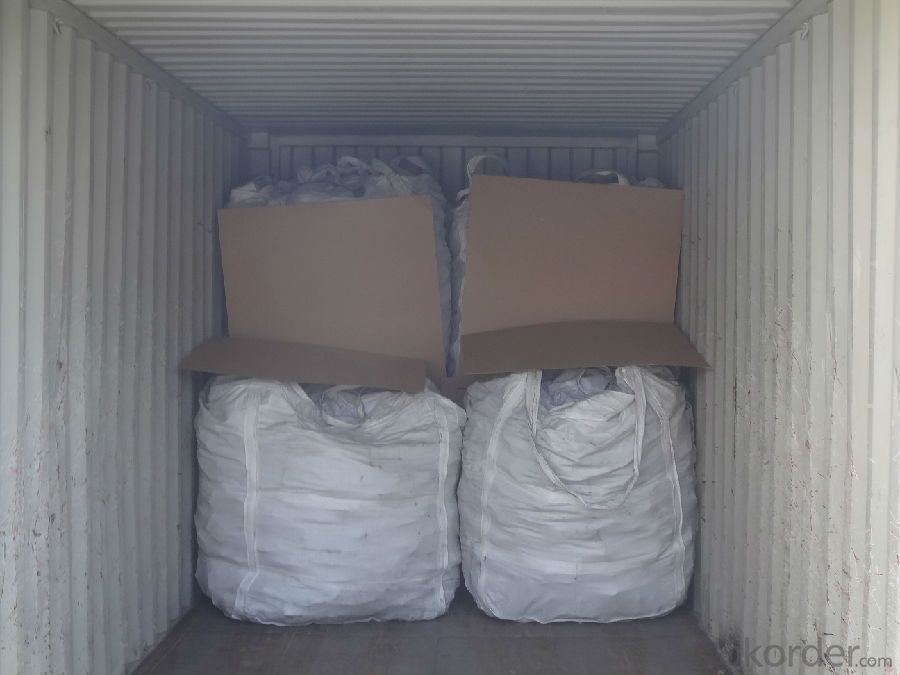
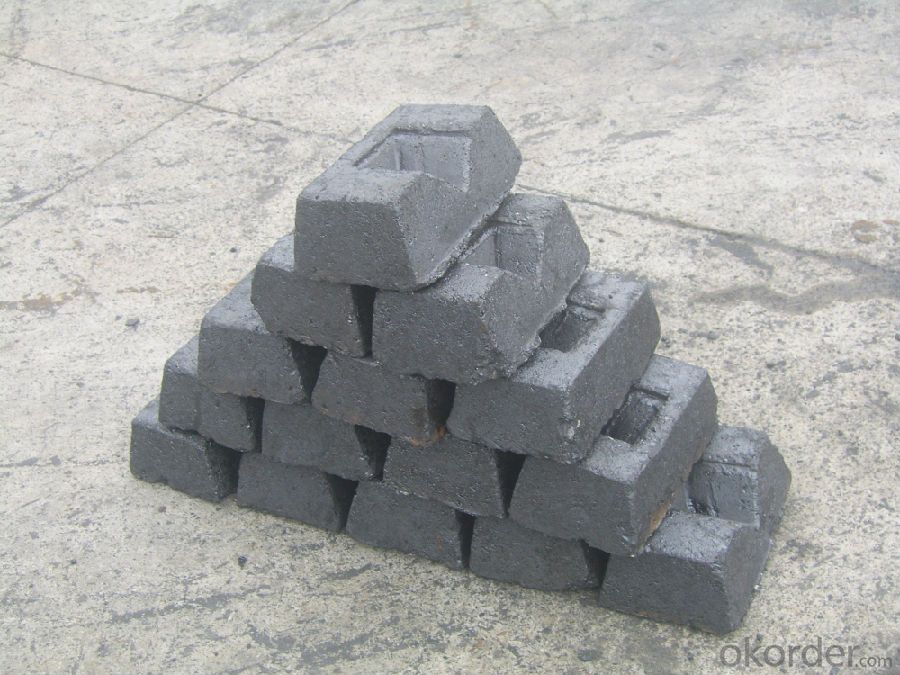
- Q: What are the impacts of carbon emissions on the stability of wetlands?
- Wetlands, which are highly sensitive ecosystems, are significantly affected by carbon emissions. The increase in greenhouse gases, especially carbon dioxide, in the atmosphere is one of the main outcomes of carbon emissions. This leads to global climate change, resulting in changes in weather, temperature, and precipitation. The impact of these climate changes on wetlands is both direct and indirect. Firstly, higher temperatures can accelerate evaporation, causing a decline in water levels within wetlands. This can lead to the drying out of wetland habitats, disturbing the delicate balance of species that depend on these areas for survival. As wetlands dry up, the plants and animals that rely on them for food, shelter, and breeding grounds are put in jeopardy. Moreover, increased carbon emissions contribute to the rise in sea levels, which poses a significant threat to coastal wetlands. Rising sea levels can result in the intrusion of saltwater into freshwater wetlands, leading to the salinization of the soil and negatively impacting the vegetation and organisms inhabiting these areas. This intrusion also disrupts the delicate equilibrium between freshwater and saltwater, affecting the diverse ecological functions provided by wetlands, such as water filtration, nutrient cycling, and flood control. Furthermore, carbon emissions are responsible for the acidification of water bodies, including wetlands. Excess carbon dioxide absorbed by water causes a decrease in pH levels, making the water more acidic. Acidic water can harm the plants, animals, and microorganisms in wetlands, affecting their growth, reproduction, and overall survival. This disruption in the wetland ecosystem can have cascading effects on the entire food web and biodiversity of these areas. In conclusion, wetlands are profoundly impacted by carbon emissions. The alteration of climate patterns, sea-level rise, and acidification of water bodies are all consequences of carbon emissions that endanger the delicate balance and ecological functions of wetlands. Recognizing the importance of wetlands and effectively mitigating carbon emissions is crucial for preserving these vital ecosystems and the numerous benefits they provide, including flood mitigation, water purification, and habitat for numerous plant and animal species.
- Q: What are the consequences of increased carbon emissions on urban areas?
- Increased carbon emissions have numerous consequences on urban areas. Firstly, it leads to a rise in air pollution, contributing to respiratory issues and increased health risks for the population. Additionally, carbon emissions contribute to the greenhouse effect, leading to higher temperatures and exacerbating the urban heat island effect, which can result in discomfort, heat-related illnesses, and increased energy demands for cooling. Moreover, increased carbon emissions contribute to climate change, leading to more frequent and intense extreme weather events like storms and heatwaves, which pose significant threats to urban infrastructure, public safety, and economic stability. Overall, the consequences of increased carbon emissions on urban areas are detrimental to both the environment and human well-being.
- Q: Often see a lot of cars made of carbon fiber body, is this material flammable?
- Carbon fiber has the characteristics of light quality, high strength and not easy to burn. More and more widely used
- Q: How is carbon used in the manufacturing of electronics?
- Carbon is used in the manufacturing of electronics in various ways. One common application is in the form of carbon nanotubes, which are used to make smaller and more efficient transistors. Carbon is also used as a component in lithium-ion batteries, providing high energy density and longer-lasting power. Additionally, carbon is used as a conductive material in circuit boards and as a protective coating to prevent static electricity buildup.
- Q: What are the different types of carbon-based alloys?
- There are several types of carbon-based alloys, including cast iron, steel, and stainless steel. Cast iron is a strong and brittle alloy with a high carbon content, while steel is a versatile and strong alloy with varying carbon content. Stainless steel is a corrosion-resistant alloy that contains a higher percentage of chromium and nickel.
- Q: How can carbon be stored underground?
- Carbon capture and storage (CCS) is a process that allows for the underground storage of carbon. This process involves the capture of carbon dioxide (CO2) emissions from industrial sources, such as power plants or cement factories, followed by the storage of the captured CO2 deep underground in geological formations. To begin, the CO2 emissions are captured before they are released into the atmosphere. Various technologies, such as post-combustion capture, pre-combustion capture, and oxy-fuel combustion, are available for this purpose. These technologies separate the CO2 from other gases, like nitrogen, resulting in a concentrated stream of CO2 that is easy to store. Once the CO2 is captured, it must be transported to a suitable storage site. Depending on the distance and location of the storage site, transportation can be done through pipelines or ships. The CO2 is then injected deep underground into geological formations, including depleted oil and gas reservoirs, saline aquifers, or coal seams. The selection of storage sites is done carefully, taking into consideration their ability to safely and permanently store the CO2. The chosen geological formations must have an impermeable rock layer, known as a caprock, to prevent CO2 leakage to the surface. Regular monitoring of the storage sites ensures that the stored CO2 remains securely underground. The storage of carbon underground has significant benefits in reducing CO2 emissions and addressing climate change. It effectively prevents the release of CO2 into the atmosphere, where it contributes to the greenhouse effect and global warming. Additionally, CCS can be combined with enhanced oil recovery (EOR) techniques, using the injected CO2 to extract more oil from depleted reservoirs, making the process economically viable. However, it is important to note that carbon storage is not a permanent solution to climate change. While it can help in reducing emissions during the transition to cleaner energy sources, it should not replace efforts to decarbonize the economy and reduce dependence on fossil fuels. Moreover, the long-term safety and environmental impacts of underground carbon storage need thorough examination to ensure its effectiveness and sustainability.
- Q: What are the impacts of carbon emissions on the stability of grasslands?
- The stability of grasslands is significantly affected by carbon emissions. When carbon dioxide (CO2) is released into the atmosphere, it contributes to the greenhouse effect and causes global warming. This rise in temperature has various harmful consequences for grasslands. To begin with, higher temperatures can disrupt the equilibrium of grassland ecosystems. Many grassland species require specific temperatures for their growth and reproduction. As temperatures increase, these species may struggle to adapt, resulting in a decline in their populations. This disruption can negatively impact the overall biodiversity and ecological stability of grasslands. Additionally, global warming can change precipitation patterns, leading to alterations in water availability in grasslands. Reduced rainfall or increased evaporation can create drought conditions, making it challenging for grasses to flourish. This can ultimately cause grasslands to transform into barren areas devoid of plant life, a process known as desertification. Moreover, carbon emissions contribute to the acidification of the oceans, which indirectly affects grasslands. Acidic ocean waters impact marine organisms, including those responsible for generating nutrients that are carried by winds to coastal and inland grasslands. If these nutrient sources decline, grasslands may experience reduced fertility and productivity, ultimately affecting the stability of these ecosystems. Lastly, carbon emissions can worsen the frequency and intensity of wildfires. Grasslands are naturally adapted to periodic fires, which play a vital role in maintaining biodiversity and regulating plant populations. However, the increase in carbon dioxide levels can fuel more severe and frequent wildfires, leading to the destruction of grasslands and making their recovery more challenging. In conclusion, carbon emissions have numerous negative impacts on grassland stability. They disrupt the balance of grassland ecosystems, change precipitation patterns, contribute to ocean acidification, and increase the risk of wildfires. These effects can result in biodiversity loss, desertification, reduced fertility, and overall instability in grassland ecosystems. It is essential to reduce carbon emissions and mitigate the consequences of global warming to ensure the long-term stability and preservation of grasslands.
- Q: What should I do when carbon monoxide leaks?
- Of course, in saving at the same time, to find out the cause of the gas leak as soon as possible, and to other people and then plugging, lest suffer. PoisoningTo avoid leakage and gas poisoning accident occurred in the home, can install household gas alarm detector | gas leak alarm, it can predict in advance the gas leak alarm, prompting the user, open the window as soon as possible to prevent accidents.
- Q: How does carbon dioxide affect the pH of seawater?
- Carbon dioxide affects the pH of seawater by causing it to become more acidic. When carbon dioxide dissolves in seawater, it reacts with water molecules to form carbonic acid. This carbonic acid then dissociates into hydrogen ions (H+) and bicarbonate ions (HCO3-), which increases the concentration of hydrogen ions in the water. The increase in hydrogen ions leads to a decrease in pH, making the seawater more acidic. This process is called ocean acidification. Ocean acidification can have detrimental effects on marine organisms, such as coral reefs, shellfish, and other marine life that depend on calcium carbonate for their shells or skeletons. It can also disrupt the balance of marine ecosystems and impact various ecological processes in the ocean.
- Q: Learn photography for nearly half a year, has always wanted to buy a tripod, want to buy carbon fiber tripod, what brand is better? The machine is D700+24-70About 3000 is too expensive ~ consider 1000 more just fine. Wage earners!
- Three tripod according to the budget to choose the brand, Nikon D700 SLR camera lens with the weight of 24-70 does not have what problem, maximum diameter of 28mm on the line.If the budget is around 7000 only buy JX, may also consider the budget nearly manfrotto.If the budget is below 3000, recommended to choose the source or berno.Budget 1000 yuan level, do not have to consider carbon fiber, and this carbon fiber three tripod does not necessarily fly.
Send your message to us
Carbon Electrode Paste with Low Ash for Ferroalloy Calcium Carbide Manufacture
- Loading Port:
- Lianyungang
- Payment Terms:
- TT or LC
- Min Order Qty:
- 20 m.t.
- Supply Capability:
- 1000 m.t./month
OKorder Service Pledge
OKorder Financial Service
Similar products
Hot products
Hot Searches
